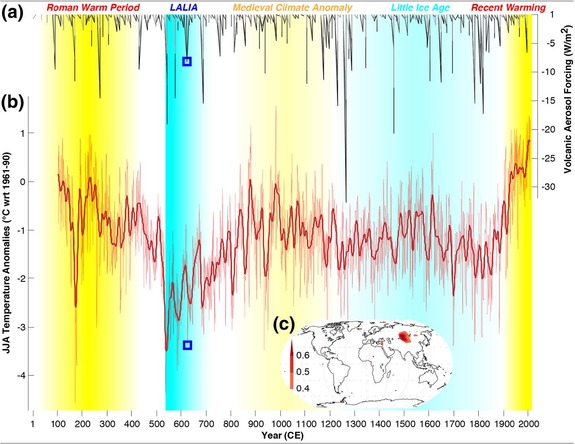Nicola Di Cosmo is Luce Foundation Professor in East Asian Studies in the School of Historical Studies at the Institute for Advanced Study. A scholar of China and inner Asia from prehistory to the present, he most recently has focused on the impact of climate change on migration patterns. He spoke with Joanne Lipman, the Institute’s Peretsman Scully Distinguished Journalism Fellow, about new climate data that is upending conventional wisdom about historic events, and how climate change may impact world events going forward. This conversation was conducted on April 15, 2020. It has been edited for length and clarity.
Joanne Lipman: As a China scholar, you have connected great historic events to climate change. Has that been done before?
Nicola Di Cosmo: Historians have been interested in climate for a long time, but the use of climate data has been controversial for some time. In recent years, thanks to growing interest in climate change, “paleoclimatology” has become much more precise. This is the science that reconstructs climate over long periods of time using natural archives, such as ice cores, tree rings, lake sediments or cave formations. In some cases, it can provide high-resolution reconstructions. Whereas previously we might have very large scales—centuries or millennia—now we can go down to a year-by-year analysis. That type of advance in science makes it possible for historians to use climate data for purposes relevant to human events, and therefore for historical research.
JL: One the areas in which you are an expert is the Mongol Empire. Can you explain the connection between climate and the growth of the Mongol Empire, which was the largest contiguous land empire in world history?
NDC: The Mongol is just one of the steppe empires, which include also the Huns (Asian and European), the ancient Turks and others that emerged from Mongolia and then expanded. The Mongols went all the way to Russia and Eastern Europe; the Turks went all the way to Central Asia. Even the fall of Rome has been attributed to nomadic invaders from Central Asia, such as the Huns. These people are central to much of premodern Eurasian history.
For a long time, it was believed that nomads left their environment—the steppes—because of some sort of climatic downturn. They couldn’t survive there because of droughts or because of other environmental disasters. Historians assumed that they were pushed out of their natural habitat by climatic events.
Instead, a study that we did with some climatologists who reconstructed the climate history of Mongolia revealed something completely different. Actually, the opposite. It was good weather that fueled the building of imperial “structures” such as the army, political centralization, the economy and so on, which allowed the Mongols to embark on a world conquering project.
JL: What do you mean by “good weather,” and how did that impact empire-building?
NDC: Weather that promotes grassland production—more precipitation (rain, moisture) and warmer climate. These are the two conditions that impact the environment. Surplus grass production reduces animal mortality, and therefore increases the number of animals available not only for food consumption but also for war. If you embark on a very large project of warfare, you need not just an enormous number of horses to start with, but also a continuous supply. So, if you have fifteen years of uninterrupted good weather, that allows you to project your military might outside your country for a long period of time.
That’s what happened with the Mongols. They have this ability that very few people had before them to launch one or two long-range military campaign every year. This is just an example showing that there is a link between climate and environment, and between environment and society, which helps us give a better explanation of a historical event.
JL: At its peak, what modern-day countries did the Mongol Empire encompass?
NDC: Mongolia, China, Russia. Iran. Afghanistan, all of the Central Asian Republics... Not quite India. They conquered Baghdad, so, parts of Iraq. They did not go beyond Russia. They tried. They invaded Hungary and Poland but had to retreat.
JL: Why did they withdraw from Hungary and Poland?
NDC: We did a climatological study to address this problem. In the winter of 1241, the Mongols get into eastern Hungary and just destroy everything. They overcome any opposition. The king of Hungary runs away and they pursue him. There seems to be absolutely no way of stopping them. So, they begin to settle in eastern Hungary. Then, in the winter, the Danube freezes over and in early 1242 they ride the horses across the Danube and invade western Hungary.
This particular winter is incredibly cold and very rainy. What happened was that, because the water table is high in Hungary and the terrain could not absorb much water, it pooled on the ground and froze. Until the 18th century, Hungary was very prone to floods because the soil could not absorb a lot of rain. In spring, when the ice thawed, much of western Hungary probably became a mud field. It became a quagmire, and the Mongols could no longer operate. They withdrew because they were sitting ducks basically, in that situation. This was, in a nutshell, our hypothesis to explain their withdrawal from eastern Europe.
JL: Why couldn’t they operate in the mud?
NDC: Because they were an army based on hundreds of thousands of horses, and their tactical operations were based on very fast movements. And, presumably, one can imagine, also, that the horses may have been sick. There are illnesses for horses connected with moving in a watery environment. Moreover, there must have been a scarcity of pasture. The food supply diminished dramatically. We looked at the soil composition, hydrogeology, climate records, archeological evidence, and we concluded that Mongols withdrew at least partly because of climatic reasons.
Some scientists (mainly from Hungary) objected to our findings. Indeed, other hypotheses have been made in the past, but our data is, in my view, unimpeachable. In any case, we were the first to do an analysis of high-resolution climatic data combined with historical information. This method showed how an historical event can be interpreted differently if you consult climate data. It’s still a hypothesis, but I think that the additional data makes it a better hypothesis than others.
JL: I was stunned when you said you were able to tell the weather in the year 1241. How do you know that level of specificity?
NDC: Because of the tree rings. Each tree grows every year a little bit and every year forms a ring. It is a complicated science. Not only do climatologists have to examine each ring but they also have to match different trees in order to have a long chronology. Relatively few living trees are a thousand years old. So, they have to use fossil trees or other dead trees found in various contexts. There are events that happen in the life of the tree—parasites and fire and so on—so, you need a certain number of trees in order to have a good reconstruction for any period.
The other method is modeling, because for certain areas for which you do not have local records, you have to take records from other areas, and then combine them in order to get a probable picture of what the climate must have been like.
JL: Are there any lessons we should be thinking about from your historical research that are relevant today?
NDC: Yes. [Laughs] I expected this question. My own interest is in how we transform this climatic scientific data into something that historians can digest and use for their own research. If you look at examples of societies that failed, then climate very often enters in a narrative of collapse. The collapse of the Roman empire, the collapse of the Maya civilization, and so on. But I think the one important lesson is that the consequences of climatic events—or, in general, natural disasters—are almost never natural.
There’s a human component in all of these disasters that can make them more or less severe, and produce different outcomes. It’s all about how prepared a certain society is and how ready people are to respond to a disaster. For instance, in China, one of the big historical questions is: can the government manage a system of granaries to respond to a famine? So that, if they had a famine in one area, they could move food from one part of the country to another. Some dynasties were able to do so and some dynasties were not.
JL: Are you referring to a specific time period in China?
NDC: This happened many times over the course of 3000 years of Chinese history. If the government is not able to respond to a crisis by being prepared for it, then that crisis becomes a rebellion, then the rebellion becomes a much larger conflict, and finally, the political system is toppled. It’s a major disaster, right? So, there are political consequences, not just economic consequences, to this. And governments should be aware of it.
That’s a lesson that is very clear from Chinese history. Historians generally know that a climate disaster is never just a natural event, and political scientists today may profit from looking at the ways in which historians connect climate, economy, and politics.
JL: What are you working on now, and does that change because of the current pandemic?
NDC: I’m finishing a couple of books which had been on the back burner for a while. The first is about climate and steppe empires. I want to use various case studies that I and others have published in scientific journals to write a book on the role of climate in the history of nomadic empires. In this way I can reach historians as well.
The second book, which I am writing with a colleague, is called Venice and the Mongols. I am attached to Venice as the place that I regard as my second home, and where I lived for a long time. It seems strange that a book about Venice and the Mongols has never been written, considering that their relations span over two hundred years. We also want to include climate and disease, because the Black Death of 1348 is supposed to have started with the Mongol siege of a Genoese town in Crimea. Recent research may change this story, but in my view the Mongol conquest and the increased traffic of people and goods between Europe and Asia—a sort of early globalization—probably created the conditions for the spread of the disease.
The connection between Italian merchants and Mongol rulers has been critical to shaping so many aspects of the 14th century, of the late middle ages. And so, living in a pandemic now, the question of the Black Death, how it spread and how people lived, becomes a little more relevant.
JL: You’ve been talking about how climate change historically impacted migration and political stability. Are there countries where we see the effect of climate change unfolding today?
NDC: I never take historical analogies too seriously, because there are too many mistakes that one could make, but they can be useful as reference points to illustrate the connections between natural and human systems. One thing that people should definitely be aware of is that this type of historical research is really starting now. It’s a new frontier of historical studies. We are just beginning to understand how historians and scientists can collaborate efficiently. It’s still an experimental stage.
What we learn as historians is that climate is important but is just one of many possible factors leading to a certain event or outcome. We should resist the temptation to attribute everything to climate, although today certainly is different from the past, because climate change is the result of human activity, and therefore we bear a different relationship to climate than past societies.
Still, the causal links between climate and history or even climate and current events, are always multiple. Climate can create conflicts, due, let’s say, to competition over scarce water resources. But the same situation can lead to a mass migration, because a portion of the population no longer has access to water. In other words, we need to consider the context in its entirety, and methods developed by historians can help.
JL: Right.
NDC: Certainly, in the future, we have this problem of scarcity of resources, climate change and increasing population. The world population after 1945 tripled. Over the past 70 years, we went from two and a half billion to seven and a half billion people. What does it mean? That consumption of natural resources has increased many times, and that even without climate change we may experience scarcity. This simple point suggests that we need to look at the full picture, not just at one element. Climate change, today as in the past, may cause wars, migrations, diseases or other events, but the causes are always multiple, and the impact may vary a great deal.
Historical research can illustrate a holistic method of looking at these connections, I would say—and that’s a possible contribution of history to addressing the problems of the present. That is to say, how we interpret the past may offer some guidance to how we understand the present.






